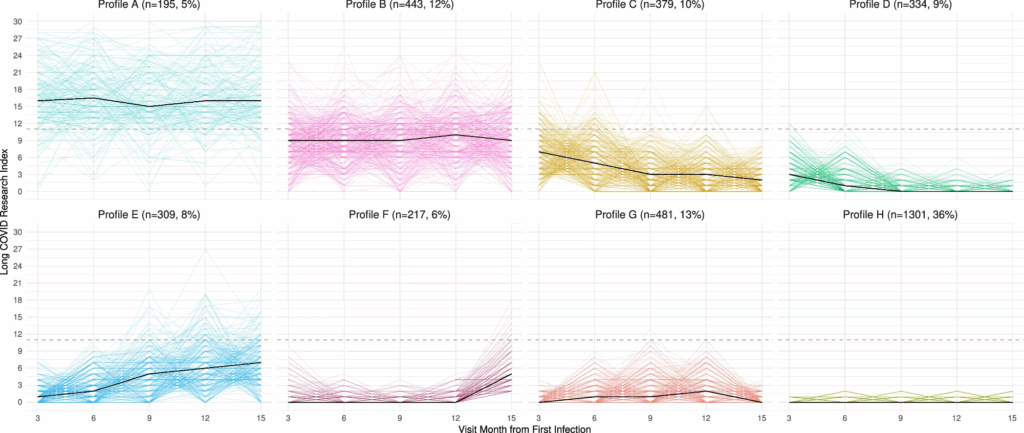There’s been a lot of news this week, but most of the articles it’s been politicians-in-other-countries-doing-stupid-things. It hasn’t just been the USA, either: UK, Scotland, Northern Ireland, New Zealand, and I forget who else all made appearances. That hasn’t left much mindshare for articles about the science and/or Canada. 🙁
COVID-19
Long COVID
This paper from USA (2025-11-17) found that 10% of participants (in a relatively large study) had Long COVID three months after their initial infection. They categorized the people who had had COVID-19 infections into eight “trajectories”:
- A (5%): persistently high burden of disease (vs. 1% of controls);
- B (12%): intermittently high symptom burden (vs. 6% of controls);
- C (10%): improving moderate symptom burden (vs. 7% of controls);
- D (9%): improving low symptom burden (vs. 5% of controls);
- E (8%): worsening moderate symptom burden (vs. 8% of controls);
- F (6%): delayed worsening symptom burden (low burden from months 3-12 but increasing at month 15, especially increasing post-exertional malaise) (vs. 6% of controls);
- G (13%): consistent, low symptom burden (vs. 20% of controls);
- H (36%): consistent minimal to no symptom burden (vs. 48% of controls).
People in groups A, B, C, and D met the definition of Long COVID, while the E, F, G, and H groups did not.

Sliced another way, of the people who had Long COVID:
- 46% had persistent Long COVID;
- 35% had moderate symptoms;
- 19% recovered.
This case studies paper from USA (2025-11-06) reports that three people with Long COVID who got pemivibart infusions — not for Long COVID, but as an alternative to a COVID-19 vaccination (because they couldn’t get a vax for various reasons) — and improved dramatically. Two of them got between two and three weeks of respite from Long COVID, but one had at least six weeks of respite.
Infusions every other week forever probably is not feasible for most people — pemivibart costs more than USD$6000 per dose — but it is a clue to the a mechanism of Long COVID.
Treatments
👃💦 This older paper from UK (2024-07-11) compared participants who did nasal irrigation with saline solution six times per day at the first sign of a respiratory infection with controls, over the course of six months. They found that participants who irrigated had ~20% fewer days of illness than those who did not.
RSV
Vaccines Immunization/Recommended Reading
💉 This op-ed (2025-11-19) talks about how the three new RSV immunization products have dramatically decreased hospitalization in old people and infants due to RSV.
To give a quick refresher, there are three new preventative measures for RSV: vaccines for people over 60, vaccines for pregnant women (targeted at their babies), and a monoclonal antibody (nirsevimab) given to babies (which acts kind of like a vaccine, in that it gives protection against future infections).
If you don’t want to read the article (which you should), here are a few studies it references:
- This paper from Spain (2024-08-16) reports, among other things, that nirsevimab was 87.6% effective against RSV bronchiolitis and 90.1% effective against ICU admission.
- This paper from Chile (2025-06-10) reports that nirsevimab was
- 76.4% effective against lower respiratory tract infection (LRTI) hospitalization,
- 84.9% effective against RSV-related ICU admission,
- 66.5% against all-cause LRTI hospitalization, and
- 47.9% against all-cause hospitalization.
- This paper from Argentina (2025-05-05) reports that vaccination of babies’ mothers was 78.6% against RSV-related LRTI hospitalization for babies under 3 months old and 71.3% for babies under 6 months old.
- For people over 60, this paper from USA (2025-05-09) reports that the RSV vaccine was 75.1% effective against infrection, and was similar against urgent care or hospitalization.
H5N1
Transmission
😬🐦⬛🤧 This (long!) article from USA (2025-11-18) makes a strong case that bird flu is transmitted from farm to farm via airborne virus.
Measles
Transmission
According to the Government of Canada Measles and Rubella Monitoring Report (updated 2025-11-17), in the week ending 8 November, the following jurisdictions had the following number of cases:
- Canada: 46;
- BC: 29;
- Alberta: 14;
- Manitoba: 2;
- Ontario: 1.
